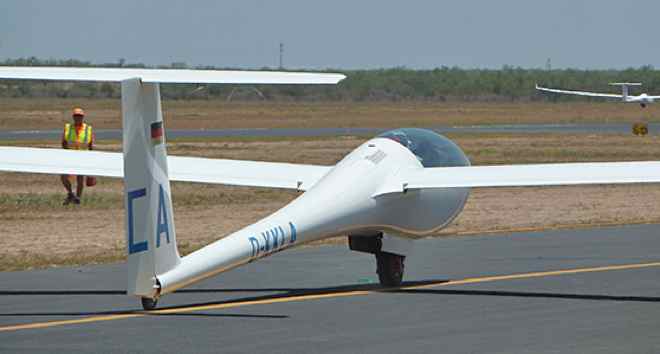© ir. Willem Langelaan OAA. All rights reserved
2022 february 12
© ir. Willem Langelaan OAA. All rights reserved
2022 february 12
HIGH PERFORMANCE SAILPLANES
planeurs de grande finesse
LANGE AVIATION
ANTARES 23
The ANTARES 23 in the World Gliding Championships, Uvalde, TX, 2012
Peter Harvey, member British Gliding Team, © Lange Aviation, 2012
Laurent Aboulin and Sylvain Gerbaud and behind was German ace Tassilo Bode – all three with Quintus. We spent a lot of time in the first week comparing notes, working on techniques, improving water filling and stealing beer.
By 9.00am, the glider was usually ready, driven over the weighing scales and parked next to the grid position (assuming no rattle snakes were found). Then breakfast as the temperature reached well into the 30s. Briefing at 10, first launch could be 11.30am. Take off, wait to start (could be 2 hours), fly the task, land at 6-7.30pm, sort the glider, clean up, eat, wash, sleep. Repeat. Repeat. Repeat. The pilots were drained. The crews were drained. The gliders were drained. Anything loose fell off. Anything weak broke. I think it reasonable to
say that if a glider component is good enough for a world championship, it should be fine for normal club use. Nothing major failed for us. We fixed a couple of minor items and made some notes for minor improvements. We were very happy.
What about the flying?
Surprisingly easy. The handling with 23m is really straightforward and not at all tiring. Our machine still had the original 18m fuselage, so rudder a little small, but no more effort than
my trusty Nimbus 4. The production Antares 23 will have a new, larger fin, so that will make co-ordination better still. The large cockpit and great ventilation meant the long flights were less tiring too. The view is exceptional from the large perspex canopy. One’s legs fit either side of the instrument binnacle allowing easy movement and stretching of the legs. It also meant that the feet can stay warm in the sun when high. Comfort levels are a vital factor for long flights and maintaining performance.
One of the most surprising factors was the Lange total energy system. In Texas, the thermals were fast bubbles of strong lift - fast, but very small. With our high cruise speeds, it was absolutely essential to pull immediately and positively into the thermal and for this, the total energy was essential. I have to say that the Antares has the best TE I have ever flown in, with negligible ‘stick thermal’ even when
converting from 220kph to 100kph in a zoom climb. I don’t want to go back to normal systems ever again!
Axel and Ludwig worked on theoretical speeds and centre of gravity calculations and we experimented with best set-up and technique to optimise Hartmut’s glider. Andor in the factory gave me technical tips and between us all, we developed a performance strategy. A real team effort.
Typical flying speeds were established as follows
Full of water, thermal between 110 and 120kph, best glide 148kph (!), cruise with flap minus 2 until 200kph, then flap minus 3. If in doubt, fly faster. This is a seriously fast machine! Even with these high speeds, it was easy to hear the air over the wing and the breakaway at stall. I found the best technique for thermalling was 110-120kph (Axel said to fly fast), with slight inside slip, listening to just avoid the sound of the breakaway.
The climb remained excellent and with the smaller span, I found I could thermal inside many others, even with the high speed. That was very helpful with the small, powerful Texas bubbles.
A negative feature of the bubbles, was flying
without a team buddy. Team flying is a normal part of top competition flying and when done well, a joy to share. My normal team mate, Steve Jones, was unable to make it this year, so I found myself flying alongside others, but without their radio help. It was all too easy to fly past a small bubble, but without a team mate to call me back.
As a strategy I found it useful to leave later and use the Antares’ performance advantage to play catch up. I am convinced the Antares held an advantage above 200kph over everything. Indeed, with three day wins, a 2nd and a 3rd place, during 7508km of flown tasks (in addition to practice) and the fastest speed ever in Uvalde of 161kph (!), it’s clear the Antares 23m has world beating performance.
But what’s it really like to fly in Texas?
Day 6 was probably the most interesting, with everything thrown at us over the 710km task.
Forecast was for possible strong development in the hill country, but a long day and little likelihood of the sea breeze penetrating too far inland. We had been achieving 140kph regularly over the last few tasks, so planned on about 5 hours. That meant waiting almost 1.5 hours before starting the 710km! I left with the Germans Tassilo Bode and Michael Sommer,
